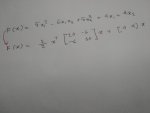\(\displaystyle \mbox{1st line: }\, F(x)\, =\, 5x_1^2\, -\, 6x_1 x_2\, +\, 5x_2^2\, +\, 4x_1\, +\, 4x_2\)
\(\displaystyle \mbox{2nd line: }\, F(x)\, =\, \dfrac{1}{2}\, x^{T}\, \left[\begin{array}{rr}10&-6\\-6&10\end{array}\right]\, x\, +\, \left[\begin{array}{rr}4&4\end{array}\right]\, x\)
I understand how to go from 2nd line to first line but not how to derive the 2nd line from the first line. How to derive those matrix?
I will guess that you are working with matrices and transformations. Also, I will guess that the following is true:
. . . . .\(\displaystyle x\, =\, \left[\begin{array}{c}x_1\\x_2\end{array}\right]\)
The conversion of the end of the first line is fairly obvious:
. . . . .\(\displaystyle 4x_1\, +\, 4x_2\, =\, \left[\begin{array}{rr}4&4\end{array}\right]\, \left[\begin{array}{c}x_1\\x_2\end{array}\right]\)
To do the rest of the conversion, we note that the variables are multiplied by themselves and each other, so more than one copy of "x" will be necessary, in some manner. We can get squaring with:
. . . . .\(\displaystyle x^T\, x\, =\, \left[\begin{array}{rr}x_1&x_2\end{array}\right]\, \left[\begin{array}{c}x_1\\x_2\end{array}\right]\, =\, \left[\begin{array}{c}x_1^2\, +\, x_2^2\end{array}\right]\)
This gets us closer, but we need more terms and the correct coefficients. Any matrix immediately following the transposed vector will have to have two rows; any matrix immediately preceding the terminal vector will have to have two columns. So let's plug a 2-by-2 matrix in between:
. . . . .\(\displaystyle x^T\, A\, x\, =\, \left[\begin{array}{rr}x_1&x_2\end{array}\right]\, \left[\begin{array}{rr}a&b\\c&d\end{array}\right]\, \left[\begin{array}{c}x_1\\x_2\end{array}\right]\)
Multiply this out, and solve for the values of the entries in A. You should get that the a
1,1 and a
2,2 entries should be 5, and that a
1,2 + a
2,1 should equal -6.
(I don't know why they threw the "1/2" in there, and I don't think it matters
how you get the -6. I checked, using a
1,2 = 0 and a
2,1 = -6, and the result came out fine.)

